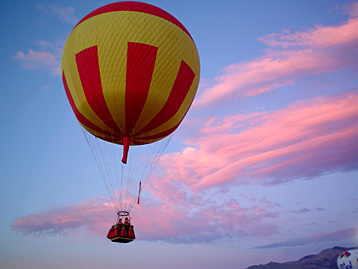Our 2005 Gordon Bennett competition
Albuquerque, New Mexico

|
Our 2005 Gordon Bennett competition Albuquerque, New Mexico
|
As dust settles, we start to rewrite our notes. We are quite satisfied with? our competition. We finished 8th out of 14 teams. However, the balloon we found did the job pretty well despite a minor gas leak. It was not porous, but there has been an oversight during the inflation: the emergency appendix hadn’t been secured and the rope got caught in the net, which caused an opening the size of a piece of pie near the bottom of the envelope. We took off around 7 pm and, slowly, we went east, drifting slightly north of Sandia Peak. The Belgium team Berben/Siméon, the winner of this year, waved at us in flight. Even if we spent a lot of sand the first night (16 bags), because of the gas leak, the remaining of the flight went well in regard of the consumption. At dawn, the winds raised to remain very strong (70 km/h on average) until dusk. Around noon, we crossed our chasing crew on the road. Unfortunately, we lost the communication around 2 pm. We haven’t been able to speak with them for the remaining of the flight. There wasn’t any cellular coverage in these areas and the radio antenna of the vehicle had been accidentally ripped off. We had a satellite telephone, but they didn’t have one. We rapidly flew over Texas, Oklahoma, Kansas and Nebraska, to get to Iowa at the beginning of the following night. We came across Wilhem Eimers from Duisburg, Germany, one of the best competitors, but soon after, they passed us as they gained altitude. They finally finished 2nd. At the beginning of the second night, the winds remained at about 50 km/h, but slightly diminished at the ground level. The airport automatic weather forecasting stations were telling us that the South winds were around 30 km/h. Since we had no more contact with our meteorologist who was in the chasing crew vehicle; we took the data of the station. It was informing us that there would be a front from Manitoba, going South-East; its lower part would be at Duluth between 10 am and 2 pm, local time. Around 2 am, we got slightly west of Minneapolis, MN. Our speed and direction would have got us over the Superior Lake 2 hours before dawn, but since we didn’t have enough details on the front, we decided to lose altitude to slow down and turn slightly to the left, to be at the South-East of the Superior Lake at dawn. We spent the remaining of the night at less than 1000 feet from the ground. The humidity level rose and our visibility diminished, but everything went well. Often, we had to jettison a little bit of sand to compensate the weight of the water droplets that we had accumulated on the net and envelope. As daylight came, we were 150 feet above the deck with a 2 mile visibility. Winds fell at less than 10 km/h. but with a sharp right turn. We try to gain altitude, but we entered in the clouds at 700 feet without coming back left. It appeared that we didn’t have any choice but to land. We did an approach above some trees and a small lake. Then we saw a nice crop field. With our very low speed of 5 km/h, it would be easy to touch the ground at the beginning of the field, just after rubbing the trees. I dropped the trail rope and it went as we expected. I even had to use the valve as we didn’t touch the ground, the rope being caught in the trees. As we touched the ground, the rain started to fall. We sheltered ourselves as we could since all the rain coming from the surface of the balloon was pouring on us. We reached the people of the control center who knew where we were, seeing us with the tracker. Our chasing crew would be there in 3 hours. Half an hour after landing, a strong gale forced us to deflate under the rain. That’s when we noticed that we were in a swamp. The vegetation was so even and alike that we though it was a cereal field that hadn’t been mowed. In fact, we could walk on it quite easily, but if we stood at the same place for too long, we would sank in the water up to our ankles. We were about 1 kilometer away from a house, but it took us about 30 minutes to get there. The resident welcomed us warmly and gave us a really good helping hand with their ATV to gather all of the equipment. It took 2 days to get back to Albuquerque. The chasing crew has traveled 4800 kilometers in 4 days. Leo Burman / Danielle Francoeur
|